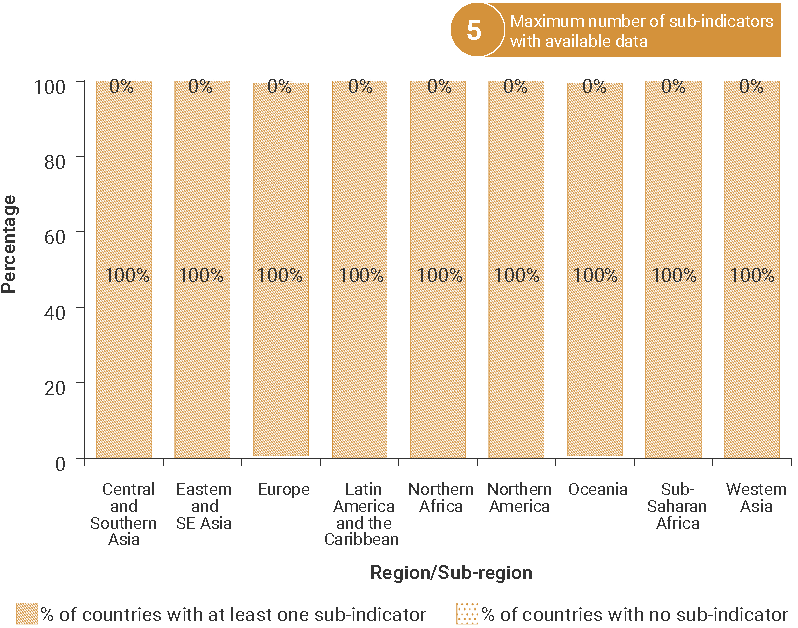Indicator 15.6.1: Number of countries that have adopted legislative, administrative and policy frameworks to ensure fair and equitable sharing of benefits
1. Key features and metadata
Definition: This indicator tracks the number of countries in accordance with the Nagoya Protocol on Access to Genetic Resources and the Fair and Equitable Sharing of Benefits Arising from their Utilization (Nagoya Protocol) (2010), the Convention on Biological Diversity (CBD) and the International Treaty on Plant Genetic Resources for Food and Agriculture (ITPGRFA) (2001).
| Sub-indicator | Disaggregated by |
|---|---|
|
ER_CBD_PTYPGRFA Countries that are contracting Parties to the International Treaty on Plant Genetic Resources for Food and Agriculture (PGRFA) (1 = YES; 0 = NO) |
No current data disaggregation available.
|
|
ER_CBD_NAGOYA Countries that are parties to the Nagoya Protocol (1 = YES; 0 = NO) |
|
|
ER_CBD_ORSPGRFA Countries that have legislative, administrative and policy framework or measures reported through the Online Reporting System on Compliance of the International Treaty on Plant Genetic Resources for Food and Agriculture (PGRFA) (1 = YES; 0 = NO) |
|
|
ER_CBD_ABSCLRHS Countries that have legislative, administrative and policy framework or measures reported to the Access and Benefit-Sharing Clearing-House (1 = YES; 0 = NO) |
|
|
ER_CBD_SMTA Total reported number of Standard Material Transfer Agreements (SMTAs) transferring plant genetic resources for food and agriculture to the country (Number) |
Sources of information: Data made available by Contracting Parties to the reporting platforms of the ABS Clearing-House, the PGRFA Online Reporting System and the national report for the ITPGRFA.
Related SDG Indicator: 2.5.1 (Number of plant and animal genetic resources for food and agriculture secured in either medium or long-term conservation facilities).
2. Data availability by region, SDG Global Database, as of 02 July 2025

3. Proposed disaggregation, links to policymaking and its impact
| Proposed disaggregation | Link to policymaking | Impact |
|---|---|---|
|
Mutually supportive national policy framework for the Nagoya Protocol and ITPGRFA (1 = YES; 0 = NO) |
In most countries, different lead agencies have responsibility for implementing the respective agreements and they have not had sufficient opportunities to coordinate their activities. The existence of a mutually supportive policy framework for these multilateral agreements (FAO 2009; CBD 2014) significantly helps streamline national implementation devoted to accessing genetic resources and benefits sharing. This disaggregation helps in monitoring the efforts deployed to coordinate both agreements and would contribute to measuring the effectiveness of ABS national policies. |
Developing mutually supportive approaches to implementation of these treaties would help avoid the duplication of regulatory mechanisms. Thereby contributing to biodiversity conservation and sustainable use. |
|
Countries that have legislative, administrative and policy framework or measures reported through the ABS Clearing-House, including elements related to the utilization of traditional knowledge associated with genetic resources (%)(CBD 2023):
|
Today, genetic resources have a wide range of commercial and non-commercial uses. In many cases the same properties that make them useful to indigenous peoples and local communities (IPLCs) are now used by industry to develop popular products. They are also used by researchers to better understand biodiversity. In both cases, traditional knowledge is a vital source of information for identifying uses of genetic resources. As a result, traditional knowledge has significant implications for the accessing and benefit-sharing of genetic resources. This disaggregation is important for developing measurestargeting an increase in the sharing of benefits with IPLCs (CBD 2012). Also, such a disaggregation would help:
|
Genetic resources and the knowledge attached to them are used in many ways by IPLCs to develop a wide range of products and services that contribute to their revenue, livelihood, well-being and culture. Those include products such as food, various biological material such as wooden products, medicines, as well as agricultural and ecosystem management practices tailored to their environment. It is essential that traditional knowledge is valued appropriately by those who use it. Having ABS measures incorporating the Nagoya Protocol provisions related to IPLCs is essential to endure that benefit-sharing flows to IPLCs. |
|
Number of materials recorded by the Multilateral System of the PGRFA, by country |
The information system put in place by the Secretariat of the PGRFA allows for a more detailed analysis of the exchange of plant genetic resources between providers and recipients at the global level. It facilitates the generation of national statistics on the actual number of materials received, not just to the number of shipments or the number of agreements concluded by users of the Multilateral System in the country (FAO n.d.d). This disaggregation provides Parties with additional quantitative and qualitative information on traded material, which is useful for monitoring the implementation of the PGRFA scheme and to adjust their policies where necessary. |
SMTA is a standard contract that sets out terms and conditions that ensure that the relevant provisions of the PGRFA are followed when transferring plant genetic material included in the Multilateral System. This proposed disaggregation would support the regulation of exchanges of plant genetic material, preventing their misuse and ensuring that any commercial benefits that arise are fairly and equitably shared. This is in line with the PGRFA core objective to protect the environment and the rights of communities while contributing to the secure exchange of plant genetic resources and the development of agriculture activities. |

